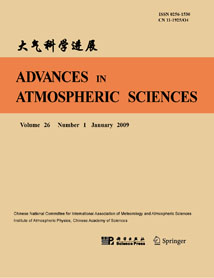| [1] |
REN Liliang, LI Chunhong, WANG Meirong,
2003: Application of Radar-Measured Rain Data in Hydrological Processes Modeling during the Intensified Observation Period of HUBEX, ADVANCES IN ATMOSPHERIC SCIENCES, 20, 205-211.
doi: 10.1007/s00376-003-0005-8
|
| [2] |
Juan HUO, Yongheng BI, Daren Lü, Shu DUAN,
2019: Cloud Classification and Distribution of Cloud Types in Beijing Using Ka-Band Radar Data, ADVANCES IN ATMOSPHERIC SCIENCES, , 793-803.
doi: 10.1007/s00376-019-8272-1
|
| [3] |
Song YANG, Eric A.SMITH,
2005: Resolving SSM/I-Ship Radar Rainfall Discrepancies from AIP-3, ADVANCES IN ATMOSPHERIC SCIENCES, 22, 903-914.
doi: 10.1007/BF02918689
|
| [4] |
ZHONG Lingzhi, LIU Liping, DENG Min, ZHOU Xiuji,
2012: Retrieving Microphysical Properties and Air Motion of Cirrus Clouds Based on the Doppler Moments Method Using Cloud Radar, ADVANCES IN ATMOSPHERIC SCIENCES, 29, 611-622.
doi: 10.1007/s00376-011-0112-x
|
| [5] |
LIU Xiaoyang, MAO Jietai, ZHU Yuanjing, LI Jiren,
2003: Runoff Simulation Using Radar and Rain Gauge Data, ADVANCES IN ATMOSPHERIC SCIENCES, 20, 213-218.
doi: 10.1007/s00376-003-0006-7
|
| [6] |
WANG Gaili, WONG Waikin, LIU Liping, WANG Hongyan,
2013: Application of Multi-Scale Tracking Radar Echoes Scheme in Quantitative Precipitation Nowcasting, ADVANCES IN ATMOSPHERIC SCIENCES, 30, 448-460.
doi: 10.1007/s00376-012-2026-7
|
| [7] |
Yang LI, Yubao LIU, Rongfu SUN, Fengxia GUO, Xiaofeng XU, Haixiang XU,
2023: Convective Storm VIL and Lightning Nowcasting Using Satellite and Weather Radar Measurements Based on Multi-Task Learning Models, ADVANCES IN ATMOSPHERIC SCIENCES, 40, 887-899.
doi: 10.1007/s00376-022-2082-6
|
| [8] |
Peilong YU, Minghao YANG, Chao ZHANG, Yi LI, Lifeng ZHANG, Shiyao CHEN,
2023: Response of the North Pacific Storm Track Activity in the Cold Season to Multi-scale Oceanic Variations of Kuroshio Extension System: A Statistical Assessment, ADVANCES IN ATMOSPHERIC SCIENCES, 40, 514-530.
doi: 10.1007/s00376-022-2044-z
|
| [9] |
Li Xin, Hu Fei, Liu Gang, Hong Zhongxiang,
2001: Multi-scale Fractal Characteristics of Atmospheric Boundary-Layer Turbulence, ADVANCES IN ATMOSPHERIC SCIENCES, 18, 787-792.
|
| [10] |
MIAO Yucong, LIU Shuhua, ZHENG Hui, ZHENG Yijia, CHEN Bicheng, WANG Shu,
2014: A Multi-Scale Urban Atmospheric Dispersion Model for Emergency Management, ADVANCES IN ATMOSPHERIC SCIENCES, 31, 1353-1365.
doi: 10.1007/s00376-014-3254-9
|
| [11] |
Wen CHEN, Renhe ZHANG, Renguang WU, Zhiping WEN, Liantong ZHOU, Lin WANG, Peng HU, Tianjiao MA, Jinling PIAO, Lei SONG, Zhibiao WANG, Juncong LI, Hainan GONG, Jingliang HUANGFU, Yong LIU,
2023: Recent Advances in Understanding Multi-scale Climate Variability of the Asian Monsoon, ADVANCES IN ATMOSPHERIC SCIENCES, 40, 1429-1456.
doi: 10.1007/s00376-023-2266-8
|
| [12] |
ZHU Kefeng, YANG Yi, Ming XUE,
2015: Percentile-based Neighborhood Precipitation Verification and Its Application to a Landfalling Tropical Storm Case with Radar Data Assimilation, ADVANCES IN ATMOSPHERIC SCIENCES, 32, 1449-1459.
doi: 10.1007/s00376-015-5023-9
|
| [13] |
FANG Xiaoyi, JIANG Weimei, MIAO Shiguang, ZHANG Ning, XU Min, JI Chongping, CHEN Xianyan, WEI Jianmin, WANG Zhihua, WANG Xiaoyun,
2004: The Multi-Scale Numerical Modeling System for Research on the Relationship between Urban Planning and Meteorological Environment, ADVANCES IN ATMOSPHERIC SCIENCES, 21, 103-112.
doi: 10.1007/BF02915684
|
| [14] |
Hengyi WENG,
2012: Impacts of Multi-Scale Solar Activity on Climate. Part I: Atmospheric Circulation Patterns and Climate Extremes, ADVANCES IN ATMOSPHERIC SCIENCES, 29, 867-886.
doi: 10.1007/s00376-012-1238-1
|
| [15] |
ZHANG Hanbin, CHEN Jing, ZHI Xiefei, WANG Yi, WANG Yanan,
2015: Study on Multi-Scale Blending Initial Condition Perturbations for a Regional Ensemble Prediction System, ADVANCES IN ATMOSPHERIC SCIENCES, 32, 1143-1155.
doi: 10.1007/s00376-015-4232-6
|
| [16] |
Yuanwen ZHANG, Guiwan CHEN, Jian LING, Shenming FU, Chongyin LI,
2021: A Case Study on MJO Energy Transport Path in a Local Multi-scale Interaction Framework, ADVANCES IN ATMOSPHERIC SCIENCES, 38, 1929-1944.
doi: 10.1007/s00376-021-1098-7
|
| [17] |
Yan GAO, Jiali FENG, Xin XIA, Jian SUN, Yulong MA, Dongmei CHEN, Qilin WAN,
2023: Multi-scale Incremental Analysis Update Scheme and Its Application to Typhoon Mangkhut (2018) Prediction, ADVANCES IN ATMOSPHERIC SCIENCES, 40, 95-109.
doi: 10.1007/s00376-022-1425-7
|
| [18] |
LI Lei, HU Fei, JIANG Jinhua, CHENG Xueling,
2007: An Application of the RAMS/FLUENT System on the Multi-Scale Numerical Simulation of the Urban Surface Layer---A Preliminary Study, ADVANCES IN ATMOSPHERIC SCIENCES, 24, 271-280.
doi: 10.1007/s00376-007-0271-y
|
| [19] |
ZHANG Zuqiang, ZHANG Renhe, Song YANG,
2007: Roles of Multi-Scale Disturbances over the Tropical North Pacific in the Turnabout of 1997--98 El Nino, ADVANCES IN ATMOSPHERIC SCIENCES, 24, 581-590.
doi: 10.1007/s00376-007-0581-0
|
| [20] |
LIU Liping, ZHUANG Wei, ZHANG Pengfei, MU Rong,
2010: Convective Scale Structure and Evolution of a Squall Line Observed by C-Band Dual Doppler Radar in an Arid Region of Northwestern China, ADVANCES IN ATMOSPHERIC SCIENCES, 27, 1099-1109.
doi: 10.1007/s00376-009-8217-1
|















 AAS Website
AAS Website 
 AAS WeChat
AAS WeChat 
 DownLoad:
DownLoad: